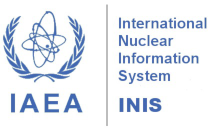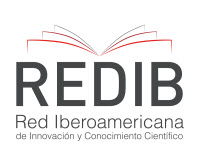Determination of radon (222Rn) activity concentration in the Institute of Radiation Protecion and Dosimetry, Rio de Janeiro, Brazil
DOI:
https://doi.org/10.15392/2319-0612.2025.2890Keywords:
radon, CR-39, Annual effective dose, Radon Activity ConcentrationAbstract
Radon is a natural radioactive element responsible for around 40% of the annual dose from natural sources of radiation. It is considered the second leading cause of lung cancer by UNSCEAR. For these reasons, it is important to determine the concentration of radon in built environments. The aim of this study was to quantify the concentration of radon on the premises of the Institute of Radioprotection and Dosimetry (IRD/CNEN). Radon concentrations were measured using CR-39 solid-state nuclear trace detectors, which were exposed for 90 days in 20 of the Institute's buildings, including rooms, offices, bathrooms and laboratories. The laboratorial procedures were conducted at the Radon Laboratory of the Environmental and Occupational Radioprotection Division (DIRAD) of the IRD/CNEN. The statistical uncertainties were provided by the equipment manufacturer's software, and the effective dose calculations strictly followed the appropriate bibliographical references. The average radon concentration found was 86.4 Bq/m³, ranging from 6.5 Bq/m³ to 285.4 Bq/m³, demonstrating compliance with national regulations. Regarding the maximum annual effective dose, for a 5-hour working day, the values ranged from 0.13 mSv/year to 1.33 mSv/year. For an 8-hour working day, the values ranged from 0.21 mSv/year to 2.14 mSv/year. Based on the concentrations obtained, it was possible to check whether the Institute's facilities meet the requirements of standard CNEN NN 3.01, as well as calculating the maximum annual effective dose for two scenarios: 5-hour and 8-hour working days.
Downloads
References
[1] UNSCEAR - United Nations Scientific Committee on the Effects of Atomic Radiation. Sources and Effects of Ionizing Radiation. Annex B - Exposures to natural radiation sources. UNSCEAR Report to the United Nations General Assembly, 2000.Journal Article reference example: SILVA, V. A.; ANDRADE, L. H. C. Etinobotânica Xucuru: mystical species. Biotemas, Florianópolis, v. 15, n. 1, p. 45-57, 2002.
[2] TAUHATA, L. et al. Radioproteção e Dosimetria: Fundamentos, Instituto de Radioproteção e Dosimetria, CNEN, RJ, Brasil, 2014.
[3] COMISSÃO NACIONAL DE ENERGIA NUCLEAR (CNEN). Norma CNEN NN 3.01 – Diretrizes Básicas de Proteção Radiológica. Rio de Janeiro: CNEN, 2014. Disponível em: https://www.gov.br/cnen/pt-br/acesso-rapido/normas/grupo-3/NormaCNENNN3.01.pdf. Acesso em: 14 set. 2024.
[4] Instituto Nacional de Câncer. (2023). Estimativa de Câncer no Brasil. Ministério da Saúde.
Disponível em: https://www.gov.br/inca/pt-br/assuntos/cancer/numeros/estimativa. Acesso em: 28 de setembro de 2024.
[5] Ishimori, Y., Lange, K., Martin, P., Mayya, Y. S., & Phaneuf, M. (2013. Measurement and calculation of radon releases from NORM residues. International Atomic Energy Agency).
[6] RADOSYS. Radosys RSFS, RSFV, RADUET, RSKS Radon Detector, RSNS Neutron Dosimeter User Manual. Disponível em: https://manualzz.com/doc/7321648/1-introduction-to-the-radosys-system. Acess em: 24 jul. 2024.
[7] UNSCEAR - United Nations Scientific Committee on the Effects of Atomic Radiation. Sources and Effects of Ionizing Radiation. UNSCEAR Report to the United Nations General Assembly, 2000.
[8] INTERNATIONAL ATOMIC ENERGY AGENCY. Radiation protection against radon in workplaces other than mines. Vienna: IAEA, 2003. (Safety Reports Series, No. 33).
[9] L'ANNUNZIATA, Michael F. (Ed.). Handbook of radioactivity analysis: Volume 1: Radiation physics and detectors. 2. ed. San Diego: Academic Press, 2003.
[10] EEB, Hajo; SHANNOUN, Ferid (Ed.). Manual da OMS sobre radônio em ambientes internos: uma perspectiva de saúde pública. 1ª ed. São Paulo, 2016.
[11] ICRP, The 2007 Recommendations of the International Commission on Radiological Protection. ICRP Publication 103, Ann. ICRP 37 (2-4) (2007)
[12] ICRP - International Commission on Radiological Protection. ICRP Publication 65: Protection Against Radon-222 at Home and at Work. Annals of the ICRP, 1993.
[13] OTERO, U. B.; SILVA, N. C.; GERALDINO, B. R.; DA-CUNHA, T. N.; ANTONIAZZI, B. N. Evaluation of indoor radon gas levels in three Brazilian municipalities located in the state of Minas Gerais. Brazilian Journal of Radiation Sciences, São Paulo, 31 maio 2024. DOI: 10.15392/2319-0612.2024.2415. DOI: https://doi.org/10.15392/2319-0612.2024.2415
[14] LOURO, Alina; PERALTA, Luís; SOARES, Sandra; PEREIRA, Alcides; CUNHA, Gilda; BELCHIOR, Ana; FERREIRA, Luís; GIL, Octávia Monteiro; LOURO, Henriqueta; PINTO, Paulo. Human exposure to indoor radon: a survey in the region of Guarda, Portugal. Radiation Protection Dosimetry, v. 154, n. 2, p. 237–244, abr. 2013. Available in: https://doi.org/10.1093/rpd/ncs166. Acess in 27 nov de 2024. DOI: https://doi.org/10.1093/rpd/ncs166
Published
Issue
Section
License
Copyright (c) 2025 Lucas Rezende, Dr. Paulo Roberto Rocha Ferreira, Dr. Fernando Carlos Araujo Ribeiro

This work is licensed under a Creative Commons Attribution 4.0 International License.
Licensing: The BJRS articles are licensed under a Creative Commons Attribution 4.0 International License, which permits use, sharing, adaptation, distribution and reproduction in any medium or format, as long as you give appropriate credit to the original author(s) and the source, provide a link to the Creative Commons license, and indicate if changes were made. The images or other third party material in this article are included in the article’s Creative Commons license, unless indicated otherwise in a credit line to the material. If material is not included in the article’s Creative Commons license and your intended use is not permitted by statutory regulation or exceeds the permitted use, you will need to obtain permission directly from the copyright holder. To view a copy of this license, visit http://creativecommons.org/licenses/by/4.0/






















